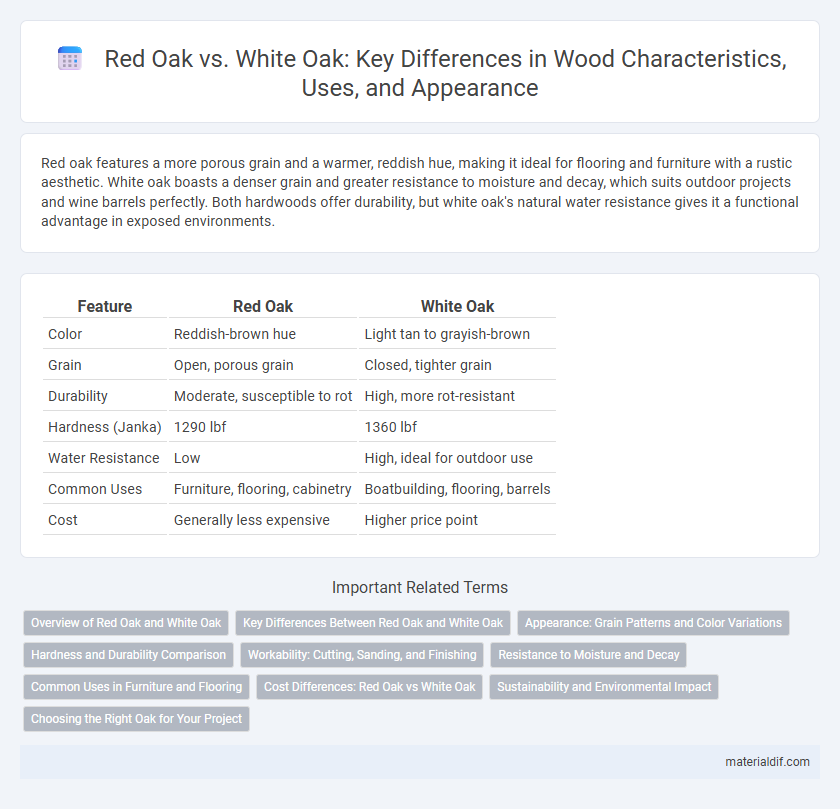Red oak features a more porous grain and a warmer, reddish hue, making it ideal for flooring and furniture with a rustic aesthetic. White oak boasts a denser grain and greater resistance to moisture and decay, which suits outdoor projects and wine barrels perfectly. Both hardwoods offer durability, but white oak's natural water resistance gives it a functional advantage in exposed environments.
Table of Comparison
| Feature | Red Oak | White Oak |
|---|---|---|
| Color | Reddish-brown hue | Light tan to grayish-brown |
| Grain | Open, porous grain | Closed, tighter grain |
| Durability | Moderate, susceptible to rot | High, more rot-resistant |
| Hardness (Janka) | 1290 lbf | 1360 lbf |
| Water Resistance | Low | High, ideal for outdoor use |
| Common Uses | Furniture, flooring, cabinetry | Boatbuilding, flooring, barrels |
| Cost | Generally less expensive | Higher price point |
Overview of Red Oak and White Oak
Red oak features a coarse grain with a pinkish to reddish hue, known for its strength and permeability, making it ideal for furniture and flooring that require stain absorption. White oak has a tighter grain structure with a light to medium brown color, renowned for its durability and water resistance, frequently used in outdoor furniture and wine barrels. Both species belong to the Quercus genus but differ significantly in grain texture, color, and moisture resistance properties.
Key Differences Between Red Oak and White Oak
Red oak features a more porous grain structure with larger, open pores, making it more absorbent and easier to stain, while white oak has a tighter, denser grain that offers superior durability and water resistance due to its tyloses-filled pores. Red oak's reddish hue contrasts with the paler, more neutral tone of white oak, influencing aesthetic choices in furniture and flooring. White oak is preferred for outdoor applications and coopering because of its natural resistance to moisture and decay, whereas red oak is commonly used for indoor furniture and millwork where its vibrant color and grain are desirable.
Appearance: Grain Patterns and Color Variations
Red oak features a prominent, open grain pattern with a warm reddish hue, often displaying a pinkish to light brown color that enhances rustic and traditional furniture designs. White oak has a tighter, more uniform grain with subtle rays that create a distinctive flecked appearance, exhibiting colors ranging from light tan to medium brown with a slight olive cast. These differences in grain texture and color variations make red oak ideal for bold, vibrant aesthetics, while white oak suits refined, elegant applications.
Hardness and Durability Comparison
Red oak has a Janka hardness rating of approximately 1,290, making it moderately hard and suitable for flooring and furniture, while white oak boasts a higher Janka hardness of around 1,360, providing greater resistance to wear and dents. White oak's denser grain structure also contributes to superior durability and moisture resistance compared to red oak, which tends to be more porous. This makes white oak a preferred choice for outdoor applications and high-traffic areas where long-term durability is critical.
Workability: Cutting, Sanding, and Finishing
Red oak is easier to cut and shape due to its open grain and softer texture, making sanding smoother and faster. White oak has a denser, tighter grain that resists cutting tools more, requiring more effort in sanding but resulting in a finer finish. Both woods absorb finishes well, though white oak's natural oils enhance stain penetration and durability, ideal for outdoor projects.
Resistance to Moisture and Decay
Red oak has a porous grain structure that makes it more susceptible to moisture absorption and decay, limiting its durability in outdoor or damp environments. White oak features a tighter, denser grain with tyloses that block water penetration, significantly enhancing its natural resistance to moisture and fungal decay. This makes white oak a preferred choice for applications requiring high durability, such as flooring, boatbuilding, and outdoor furniture.
Common Uses in Furniture and Flooring
Red oak is widely used in furniture and flooring for its affordability and distinctive reddish hue, offering a warm, classic appearance ideal for traditional home styles. White oak's tighter grain and greater durability make it preferred for high-end furniture and flooring, particularly in areas requiring moisture resistance like kitchens and bathrooms. Both types are valued for their hardness and ability to accept stains evenly, enhancing the natural wood grain in various interior design applications.
Cost Differences: Red Oak vs White Oak
Red oak generally costs less than white oak due to its wider availability and faster growth rate, making it a more budget-friendly option for flooring and furniture. White oak's higher price reflects its superior density, durability, and resistance to moisture, which is ideal for outdoor and high-wear applications. Choosing between red oak and white oak often depends on balancing initial cost versus long-term performance and maintenance expenses.
Sustainability and Environmental Impact
Red oak and white oak both rank high in sustainability due to their natural abundance in North America and their ability to grow in diverse climates. White oak holds a slight edge in environmental impact, as its denser grain structure enhances durability and reduces the need for chemical treatments, promoting longer product life and less frequent replacement. Harvesting practices for red and white oak emphasize responsible forestry management, ensuring regeneration and minimal ecosystem disruption.
Choosing the Right Oak for Your Project
Red oak offers a prominent grain pattern and a warm, reddish hue ideal for rustic furniture and flooring, while white oak features a tighter grain and higher resistance to moisture, making it suitable for outdoor projects and wine barrels. Choosing the right oak depends on project requirements like durability, aesthetics, and exposure to elements; white oak's natural waterproof properties outperform red oak in humid or wet conditions. Consider hardness, with white oak scoring higher on the Janka scale (1360 vs 1290), to ensure longevity and strength in your woodworking project.
Red oak vs White oak Infographic

 materialdif.com
materialdif.com